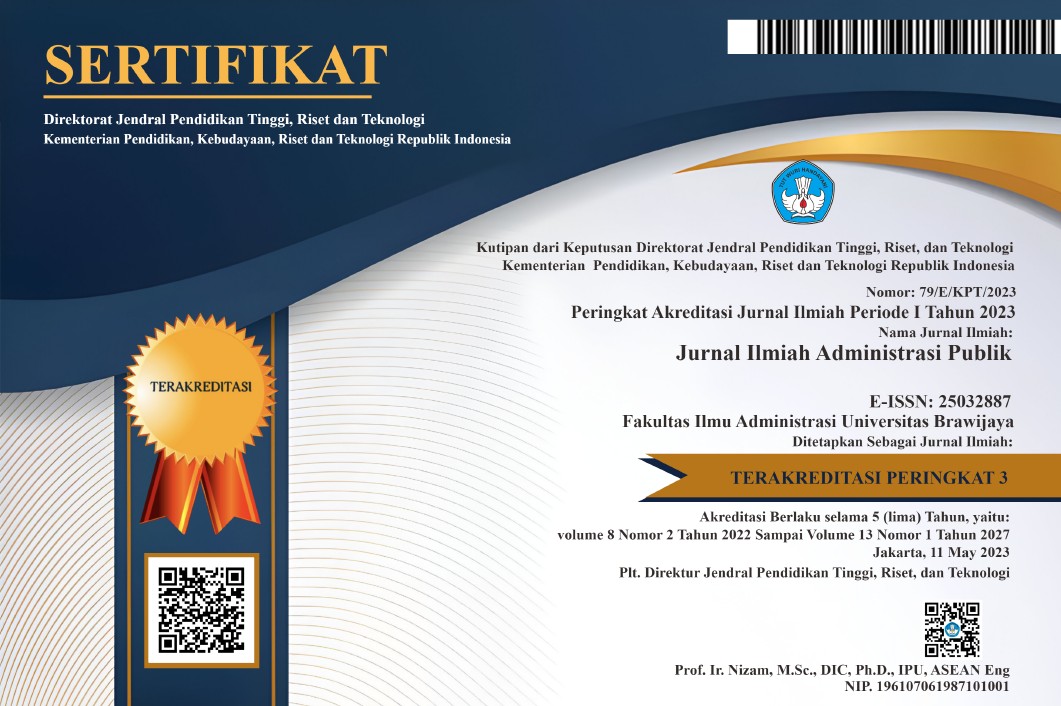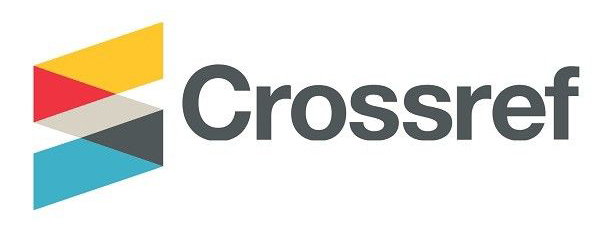Kepatuhan Kelompok Sasaran sebagai Penentu Keberhasilan Implementasi Kebijakan: Studi Kasus Implementasi PERDA Kota Bandung Nomor 4 Tahun 2011 tentang Penataan dan Pembinaan Pedagang Kaki Lima
DOI:
https://doi.org/10.21776/ub.jiap.2015.001.02.5Keywords:
implementasi kebijakan, kepatuhan kelompok sasaran, pedagang kaki limaAbstract
The management and organisation of street vendors in Bandung City Government is regulated through the Local Government Act of Bandung City Number 4 Year 2011. The implementation of this local government act, however, is unsuccesful due to internal factor from the street vendors themselves as well as external factors such as the buyers. Both street vendors and the buyers showed non-compliance behaviors toward the regulation implementation. Using qualitative research design, this research showed evidence that factors such as (1) lack of incentives and heavy sanctions; (2) problem of monitoring; (3) lack of resources; (4) lack of autonomy; (5) lack of information and (6) belief and values. The results suggest a design for reshape and redesign the public policy in the management and organisation of street vendors. It highlights six aspects need to be done; (1) the involvement of ‘street level bureaucrats’; (2) consistent law enforcement; (3) incentive for compliance behaviour; (4) regards the cost and risk bear by the street vendors in the evaluation and re-designing of the policy; (5) the capacity development of the street vendors association and (6) developing a model for an effective information disseminationReferences
Alisyahbana. (2003). Urban hidden economy, peran tersembunyi sektor informal perkotaan, Lembaga Penelitian ITS. Surabaya.
Anderson, J.E. (1994). Public policymaking: an introduction, Boston: Houghton Mifflin.
Berner, G.E., Gomez, G.M. & Knorringa, P. (2012). Helping a large number of people become a little less poor: The logic of survival entrepreneurs. European Journal of Development Research, 24(3), 382-396.
Bridgman, P. & Davis, G. (2000), The Australian policy handbook (2n Edition), Allen & Unwin.
Colebatch, H.K. (1998), Policy, Buckingham, Open University Press.
Howlett, M. & Ramesh, M. (1995), Studying public policy: policy cycles and policy subsystems, Don Mills, Ontario: Oxford University Press.
Imas, JM., Wilson, N, & Weston, A. (2012). ‘Barefoot entrepreneurs. Organization, 19, 563-585.
Lindblom, C.E (1980), The policy making process, New Jersey: Prentice Hall.
Linder, S.H. and Peters, B.G. (1989), Instruments of government: perceptions and contexts, Journal of Public Policy, 9(1): 35 – 58.
Majone, G. & Wildavsky, A. (1984) Implementation as evolution in A.Pressman and A. Wildavsky (eds), Implementation, 3rd edition, Berkeley: University of California Press.
Organization for Economic Co-operation and Development (2000), Reducing the risk of policy failure: Challenges for regulatory compliance. OECD: Paris.
Patton, C.V. & Sawicki, D.S. (1993), Basic methods of policy analysis and planning, New Jersey: Prentice Hall.
PERDA Nomer 4 Tahun 2011 Penataan dan Pembinaan Pedagang Kaki Lima
Pressman, J. & Widalvsky, A. (1973), Implementation, Berkeley: University of California Press.
Rachmawati (2014) Informal sector and local government revenue: The Contribution of Street Vendors, Jurnal Administrasi Publik, 11(1).
Rachmawati (2010) Warung sang ‘Survival Entrepreneur’ KOMPAS, 25 Februari 2010.
Rachmawati (2011) Menguatkan survival entrepreneur, KONTAN, 26 September 2011.
Ripley, R.B. (1985) Policy analysis in political science, Chicago: Nelson-Hall.
Ripley, R.B. & Franklin, G.A. (1986), Policy implementatin and bureaucracy, Dorsey Press, Chicago, illinois.
Weaver, R.K. (1990), Target compliance: The final frontier of policy implementation, Issues in Governance Studies, 27.
Downloads
Published
Issue
Section
License
If your paper is accepted, the author identified as the formal corresponding author for the paper will receive an email prompting them to login into Author Services; where via the JIAP Author Licensing Service they will be able to complete the license agreement on behalf of all authors on the paper.














